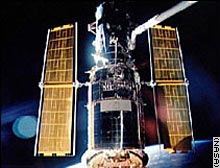NASA Director: "We will save the Hubble Space Telescope" * The American space agency has finally decided to try and save the Hubble, the American space telescope that is placed in space and observes farther and more accurately than any telescope on earth.
concentration of sources

Direct link to this page: https://www.hayadan.org.il/hubble120804.html
The American space agency finally decided to try and save the Hubble, the American space telescope that is placed in space and observes farther and more accurately than any telescope on earth.
The telescope, which has been in space for years, is suffering from several malfunctions and is supposed to "fall" slowly towards the Earth, until it hits the atmosphere and burns up. NASA thought until today that since the space shuttles were disabled after the Columbia disaster, it had no way to try and repair the telescope, but a large public pressured NASA to change the decision and save the telescope, which was responsible for some amazing discoveries in recent years.
At the moment, it seems that NASA's new decision to save the Hubble will be carried out using "Dexter", a special space robot that was created at the Canadian Space Agency, and will probably be launched to the "Hubble" telescope in 2007 along with additional batteries, spare parts and modern scientific instruments.
Following the Columbia disaster, O'Keeffe issued a directive preventing the launch of additional manned missions to Hubble to prevent the risk of astronauts and crew members. According to the original plan, the space telescope was supposed to cruise in space, and continue to work until technical faults shut it down for good. In doing so, mourning, as well as many studies based on and using it, is condemned to death. According to the estimate, without regular maintenance and repairs, the Hubble Space Telescope is expected to stop transmitting useful information to Earth in 2007 or early 2008.
Despite suggestions from a team of influential researchers at NASA and beyond, and a large lobby of scientists and researchers who called for Hubble to be saved, O'Keeffe seems determined not to change his mind on the matter. Therefore, NASA's decision to save the Hubble was accepted with great joy, among other things among scientists whose projects they were working on were about to be closed due to the decline in the telescope's function.
At the beginning of the month, one of the four central instruments on the telescope - the STIS - the imaging spectrograph, broke down. This device separates the light coming from different celestial bodies into the colors that make it up, thus allowing astronomers to discover data about the temperature, composition, density and movement of these objects. It is used to study black holes, to discover faint stars that provide clues to the age of the universe, and to study the atmospheres of planets outside the solar system. The STIS consumed about 30 percent of Hubble's observation time and its importance to astronomical research is the greatest.
In the years of his activity, Hubble deepened his gaze into the most distant galaxies, looked into the depths of the universe and discovered cosmological systems that were unknown to science. He presented the researchers with an accurate picture of the universe in its early days, went back in time to the early days of the universe's formation, and analyzed findings from many stars in our immediate and distant environment.
Hubble is the largest and most important space telescope. It was launched in 1990, and repaired by NASA astronauts in 1993, after a malfunction in one of its cameras was discovered. Hubble's place in space will be taken by the "James Webb" space telescope, which will go into space in 2011, at the earliest.
The capabilities of a telescope in space exceed those of a ground telescope, and therefore the decision to stop the manned flights was received with astonishment in the astronomer community.
NASA Administrator Sean O'Keefe ordered engineers at the Goddard Flight Center in Maryland to begin work that would allow the robot to be launched in 2007. "Everyone says, 'We want to save the Hubble,'" said O'Keefe, "so let's do it."
https://www.hayadan.org.il/BuildaGate4/general2/data_card.php?Cat=~~~921707208~~~210&SiteName=hayadan
